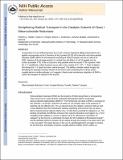Deciphering Radical Transport in the Large Subunit of Class I Ribonucleotide Reductase
Author(s)
Stubbe, JoAnne; Nocera, Daniel G.; Holder, Patrick; Pizano, Arturo Alejandro; Anderson, Bryce Lane
DownloadStubbe_Deciphering radical.pdf (2.147Mb)
PUBLISHER_POLICY
Publisher Policy
Article is made available in accordance with the publisher's policy and may be subject to US copyright law. Please refer to the publisher's site for terms of use.
Terms of use
Metadata
Show full item recordAbstract
Incorporation of 2,3,6-trifluorotyrosine (F[subscript 3]Y) and a rhenium bipyridine ([Re]) photooxidant into a peptide corresponding to the C-terminus of the β protein (βC19) of Escherichia coli ribonucleotide reductase (RNR) allows for the temporal monitoring of radical transport into the α2 subunit of RNR. Injection of the photogenerated F[subscript 3]Y radical from the [Re]–F[subscript 3]Y−βC19 peptide into the surface accessible Y731 of the α2 subunit is only possible when the second Y730 is present. With the Y–Y established, radical transport occurs with a rate constant of 3 × 10[superscript 5] s[superscript –1]. Point mutations that disrupt the Y–Y dyad shut down radical transport. The ability to obviate radical transport by disrupting the hydrogen bonding network of the amino acids composing the colinear proton-coupled electron transfer pathway in α2 suggests a finely tuned evolutionary adaptation of RNR to control the transport of radicals in this enzyme.
Date issued
2011-11Department
Massachusetts Institute of Technology. Department of ChemistryJournal
Journal of the American Chemical Society
Publisher
American Chemical Society (ACS)
Citation
Holder, Patrick G., Arturo A. Pizano, Bryce L. Anderson, JoAnne Stubbe, and Daniel G. Nocera. “Deciphering Radical Transport in the Large Subunit of Class I Ribonucleotide Reductase.” Journal of the American Chemical Society 134, no. 2 (January 18, 2012): 1172-1180.
Version: Author's final manuscript
ISSN
0002-7863
1520-5126